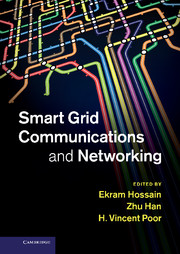Book contents
- Frontmatter
- Contents
- List of contributors
- Preface
- Part I Communication architectures and models for smart grid
- 1 Communication networks in smart grid: an architectural view
- 2 New models for networked control in smart grid
- 3 Demand-side management for smart grid: opportunities and challenges
- 4 Vehicle-to-grid systems: ancillary services and communications
- Part II Physical data communications, access, detection, and estimation techniques for smart grid
- Part III Smart grid and wide-area networks
- Part IV Sensor and actuator networks for smart grid
- Part V Security in smart grid communications and networking
- Part VI Field trials and deployments
- Index
2 - New models for networked control in smart grid
from Part I - Communication architectures and models for smart grid
Published online by Cambridge University Press: 05 January 2013
- Frontmatter
- Contents
- List of contributors
- Preface
- Part I Communication architectures and models for smart grid
- 1 Communication networks in smart grid: an architectural view
- 2 New models for networked control in smart grid
- 3 Demand-side management for smart grid: opportunities and challenges
- 4 Vehicle-to-grid systems: ancillary services and communications
- Part II Physical data communications, access, detection, and estimation techniques for smart grid
- Part III Smart grid and wide-area networks
- Part IV Sensor and actuator networks for smart grid
- Part V Security in smart grid communications and networking
- Part VI Field trials and deployments
- Index
Summary
Introduction
There is a growing communication and computation infrastructure in support of the transfer of electrical energy in both the high-voltage (HV) transmission network and the medium and low-voltage (MV/LV) distribution side. Rather than passively witnessing this trend, research efforts are ongoing to study systematically how information architectures can renew and advance power systems. They go under the umbrella of smart grid.
To advance this field, it is useful to understand why and in what form this information infrastructure has come about in the first place, and what challenges are intrinsic in the network design problem. Then, we can start questioning if new information networks can be a game changer in the energy sector, and can contribute, in more fundamental ways, to advance power-delivery systems. Can cheap information bits and computation flops make greener and cheaper joules flow in the system? That is the question. Some argue that a positive answer may amount to no less than ensuring prosperity for our species [1]. Clearly, the attention on bits and flops cannot replace other parallel investigations. But this research deserves some of the spotlight, along with carbon capture, nuclear fusion and other similarly motivated scientific quests centred around sustainable electrical energy systems.
The aim of this chapter is to envision what possible evolution of the power grid cyber-physical system can address the important issue of scaling up the generation capacity of the system, while relying increasingly on green energy and increasing the transmission efficiency.
Information
- Type
- Chapter
- Information
- Smart Grid Communications and Networking , pp. 34 - 68Publisher: Cambridge University PressPrint publication year: 2012
Accessibility standard: Unknown
Why this information is here
This section outlines the accessibility features of this content - including support for screen readers, full keyboard navigation and high-contrast display options. This may not be relevant for you.Accessibility Information
- 1
- Cited by
